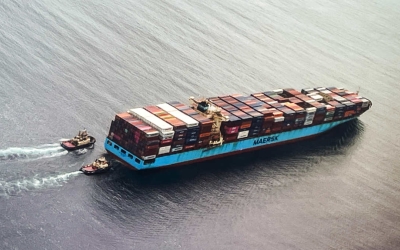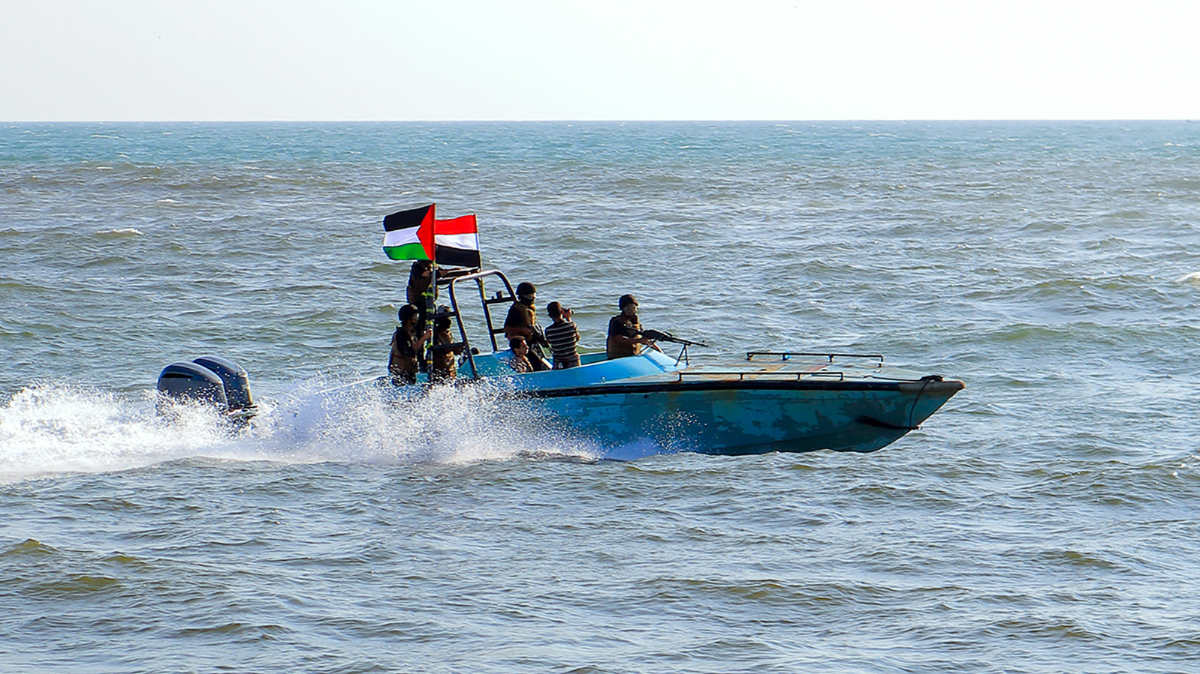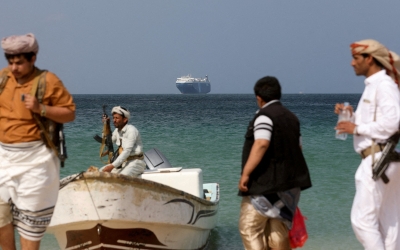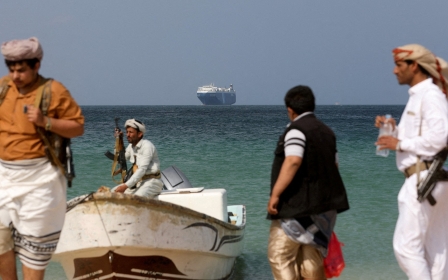How the Houthis mined commercial intelligence to sabotage global trade

Houthi rebels in Yemen are tapping into troves of commercially available maritime intelligence to locate and attack vessels in the Red Sea, current and former western defence officials and maritime experts say.
The Houthis' use of publicly available ship navigation data and other information that can be obtained with paid subscriptions on maritime intelligence sites is an unprecedented case of an Iran-backed group deploying open-source information widely accessible in the West against the US and its allies.
“The Houthis have shown that with a computer and internet access, and maybe the help of a VPN, just how much data is available in the maritime space,” Corey Ranslem, chief executive of maritime risk advisory and security company Dryad Global, told Middle East Eye.
The Houthis, once a mountain rebel group, whom one US lawmaker derided as “goat herders”, have catapulted to global prominence for their audacious maritime drone and missile attacks, which they say are on behalf of besieged Palestinians in Gaza.
Their attacks have disrupted global trade rippling across continents, denting Egypt’s Suez Canal revenue and shuttering Tesla and Volvo factories in Europe.
Stay informed with MEE's newsletters
Sign up to get the latest alerts, insights and analysis, starting with Turkey Unpacked
The US and UK have responded to the Houthi attacks with air strikes, but they have so far been an ineffective deterrent.
The starting point for Houthi attacks, western defence officials and maritime intelligence experts tell MEE, is basic ship identification and navigation data that everyone from rookie social media snoops to sleuthing journalists and powerful navies use to track vessels.
Vessels ping their location via satellite transponders, known as automatic identification systems, or AIS. With an AIS signal, a ship’s location and route can be picked up. Sites like Marine Traffic provide AIS data, but it can also be obtained with an antenna and home receiver, Ranslem says.
Ships travelling through the Red Sea are communicating directly with the Houthis via AIS. They are using the system to ping that they are travelling with an all-Chinese or even Turkish crew to dissuade the Houthis from attacking them. Others are saying they have no contact with Israel, hoping to avoid being targeted.
Late last year, when the Swan Atlantic chemical tanker was attacked by the Houthis, the owner blamed Marine Traffic for incorrectly stating that the vessel was managed by an Israeli-linked company.
'In the business'
The battle-hardened Houthis have carved out a de facto state in northeastern Yemen, where they control the capital, Sanaa, and the important port city of Hodeidah, which had a modest shipping industry before Yemen's civil war.
They have been trained and armed by Hezbollah and Iran, US officials say. The head of Iran's operations in Yemen is Abdolreza Shahlai, a high-ranking commander in Iran’s Islamic Revolutionary Guard's Quds Force based in Sanaa, according to the US.
The chief of the Houthi naval forces, Mansur al-Saadi, gained years of experience overseeing attacks on vessels in the Red Sea when the Houthis were fighting a coalition of Arab states led by Saudi Arabia. According to the US, Saadi received extensive training in Iran.
“Of course, the Houthis have demonstrated they are using basic, public maritime information like AIS,” Nikos Georgopoulos, a former Greek special forces officer and expert on maritime security at Diaplous told MEE, but to successfully launch their attacks, they need more.
“What they also have is access to information which isn’t secret, but is hard to find. And you have to be in the business, in maritime intelligence to know. You aren’t finding it out in there in the Yemeni desert.”
While public AIS data is a starting point for the Houthis, free sites like Marine Traffic don’t provide satellite tracking access, which the Houthis would need to effectively target vessels, Michelle Wiese Bockmann, a senior shipping analyst at Lloyd’s List Intelligence, told MEE.
Besides supplying the Houthis with advanced ballistic missile and cruise missile components, the US says that Tehran is providing the Houthis with real-time intelligence and expertise to launch their attacks.
Until recently, Iran was believed to have a spy ship in the Red Sea that could help the Houthis locate vessels. According to Tankertackers.com, the vessel departed the northern half of the Red Sea in mid-January to return to Iran’s Bandar Abbas port. It is now anchored off Djibouti
How a ship finds itself on the Houthis’ target list remains murky and a point of debate in defence circles.
One senior western defence official with extensive experience watching the Houthis said Iran is probably relishing the fact that its ally is targeting certain ships and giving a pass to others, implementing a rudimentary form of maritime sanctions. Heavily sanctioned Iran has had to turn to a dark fleet of tankers to sell its oil.
“It’s absolutely critical to the Iranians that the Houthis target the right vessels and don’t target the wrong ones,” the official told MEE.
But the official said even western intelligence agencies are unsure exactly who is picking targets. Without citing specific intelligence, the official believes the Houthis are collecting information on targets themselves with open source data and radar, but the Iranians are “providing check after check after check”.
Dhow reconnaissance
The US has focused its air strikes on Houthi radar sites and drones, in a bid to cripple their ability to track ships. But the Houthis endured years of intense bombardment from a Saudi-led military coalition, and operate nimbly with their gear on vehicles, according to a report by the Combating Terrorism Center at West Point.
The Houthis also have a centuries-long seafaring tradition to lean on.
Ranslem, at Dryad Global, said his firm has detected patterns of suspicious approaches to vessels by small dhows, “a few hours later those same vessels come under attack”.
“It's a textbook case of old-school visual reconnaissance,” he said.
In November, the Houthis began targeting Israeli-owned and operated ships, in what they said was solidarity with Palestinians in Gaza.
One of their first acts was a brazen seizure by helicopter of the Galaxy leader, a Bahamas-flagged commercial vessel owned by Israeli business tycoon, Rami Ungar.
By early December, Israeli ship owners and operators like Zim had all but given up on the Red Sea. In search of more targets, the Houthis broadened their campaign to all ships simply visiting Israel.
The Houthis attacked the Norwegian-flagged Strinda after seeing that the chemical tanker was set to visit the Israeli port of Ashdod on the port’s website.
Since the Biden administration began its air campaign, the Houthis have said they will be broadly targeting any ships linked to the US and UK.
Paywall
The shipping industry is clouded in secrecy.
Plying goods on the high seas is by nature a global business. A vessel can have owners, operators and charters from different countries. Meanwhile, the ownership of a vessel can change multiple times a year and be obscured behind layers of shell companies.
Besides the name of a vessel, the Houthi officers up the chain of command would want its IMO number, maritime experts say.
'It’s absolutely critical to the Iranians that the Houthis target the right vessels and don’t target the wrong ones'
- Senior western defence official
This is a unique seven-digit code that is written on the exterior of vessels and provides a paper trail on their activity. Even with the IMO, tracking down what the shipping industry calls "beneficial owners" takes some level of skill.
In the West, investigators and insurance companies use databases like Lloyd’s List, which requires a subscription that can cost thousands of dollars a year.
Lloyd’s list and even Marine Traffic have a vetting process, and their sites can be difficult to access in Yemen and Iran. But experts say Iranian and Houthi intelligence could easily overcome this.
“If the Houthis or Iran had access to intelligence from people with a commercial shipping background, it would be relatively easy to determine beneficial ownership without relying on paywalled information,” Bockmann told MEE.
The US has said the Houthis are indiscriminately targeting ships in the Red Sea, but Dirk Siebels, a maritime security expert at Risk Intelligence, a Danish risk assessment firm, said that was “a political argument, not one that is backed up by the available evidence”.
“The Houthis have had some collateral damage, but all in all, they have been pretty accurate,” he told MEE.
Chinese shipping companies flock to Red Sea
Last week, the Houthis attacked the Marlin Luanda tanker, even though it was carrying refined Russian oil products.
Underscoring the global nature of the shipping industry, the vessel is operated by a British company on behalf of commodities trading firm, Trafigura, which is domiciled in Singapore and run by an Australian CEO.
Other ships with no apparent links to Israel or even the US and UK have been struck.
But the Houthis themselves have publicly touted that they will not target ships from China and Russia as long as vessels are not connected with Israel.
On Thursday, the IMF said container shipping through the Red Sea was down 30 percent compared to before the Gaza war.
Shipping giants Maersk and Hapag-Lloyd have shunned the Red Sea in favour of longer journeys around Africa as a result of the Houthi attacks, although many vessels linked to China, Russia and Arab states continue to transit.
Lloyd’s list said there were still 199 cargo vessels alone in the Red Sea last week. Energy industry experts tell MEE vessels carrying Russian oil are still transiting the Red Sea along with those of Saudi Aramco.
Major Chinese ship owner Cosco has detoured, but since the Houthi attacks started, new Chinese shipping lanes have sprung up adverting their transit through the Red Sea with port calls in Istanbul in Turkey and Jeddah in Saudi Arabia, in a bid to capitalise on the dearth of ships.
Shipping companies and vessel owners are also chalking up handsome profits as a result of the attacks, MEE previously reported.
By forcing vessels plying East-West trade to take a longer journey around Africa, the Houthis have reduced the supply of ships on the market and added on extra travel costs that can be passed on to consumers.
The cost to ship a standard 40-foot container from Asia to northern Europe has more than quadrupled, according to Xeneta.
The US has asked China to use its ties with Iran to try and rein in the Houthis, but on Thursday, US Secretary of Defence Lloyd Austin said Washington had seen “no visible evidence” Beijing was doing so.
“The Iranians are very happy with the image the Houthis are creating of Russian and Chinese vessels being safe," the western official told MEE.
Middle East Eye delivers independent and unrivalled coverage and analysis of the Middle East, North Africa and beyond. To learn more about republishing this content and the associated fees, please fill out this form. More about MEE can be found here.








